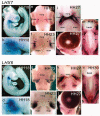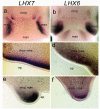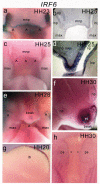Expression profiles of cIRF6, cLHX6 and cLHX7 in the facial primordia suggest specific roles during primary palatogenesis
- PMID: 16563169
- PMCID: PMC1436017
- DOI: 10.1186/1471-213X-6-18
Expression profiles of cIRF6, cLHX6 and cLHX7 in the facial primordia suggest specific roles during primary palatogenesis
Abstract
Background: The LIM-homeodomain transcription factors LHX7 and LHX6 have been implicated in palatogenesis in mice and thus may also contribute to the incidence of isolated palatal clefts and/or clefts of the lip and primary palate (CL/P) in humans. Causative mutations in the transcription factor IRF6 have also been identified in two allelic CL/P syndromes and common polymorphisms in the same gene are significantly associated with non-syndromal CL/P in different populations.
Results: Here we report the isolation of chick orthologues of LHX7, LHX6 and IRF6 and the first characterisation of their profiles of expression during morphogenesis of the midface with emphasis on the period around formation of the primary palate. LHX7 and LHX6 expression was restricted to the ectomesenchyme immediately underlying the ectoderm of the maxillary and mandibular primordia as well as to the lateral globular projections of the medial nasal process, again underlying the pre-fusion primary palatal epithelia. In contrast, IRF6 expression was restricted to surface epithelia, with elevated levels around the frontonasal process, the maxillary primordia, and the nasal pits. Elsewhere, high expression was also evident in the egg tooth primordium and in the apical ectodermal ridge of the developing limbs.
Conclusion: The restricted expression of both LHX genes and IRF6 in the facial primordia suggests roles for these gene products in promoting directed outgrowth and fusion of the primary palate. The manipulability, minimal cost and susceptibility of chicks to CL/P will enable more detailed investigations into how perturbations of IRF6, LHX6 and LHX7 contribute to common orofacial clefts.
Figures




Similar articles
-
Fate map of the developing chick face: analysis of expansion of facial primordia and establishment of the primary palate.Dev Dyn. 1998 May;212(1):102-18. doi: 10.1002/(SICI)1097-0177(199805)212:1<102::AID-AJA10>3.0.CO;2-9. Dev Dyn. 1998. PMID: 9603428
-
Cell autonomous requirement for Tgfbr2 in the disappearance of medial edge epithelium during palatal fusion.Dev Biol. 2006 Sep 1;297(1):238-48. doi: 10.1016/j.ydbio.2006.05.014. Epub 2006 May 19. Dev Biol. 2006. PMID: 16780827
-
Expression of cLhx6 and cLhx7/8 suggests a pallido-pedunculo-preoptic origin for the lateral and medial parts of the avian bed nucleus of the stria terminalis.Brain Res Bull. 2008 Mar 18;75(2-4):299-304. doi: 10.1016/j.brainresbull.2007.10.034. Epub 2007 Nov 20. Brain Res Bull. 2008. PMID: 18331888
-
The genetics of isolated orofacial clefts: from genotypes to subphenotypes.Oral Dis. 2009 Oct;15(7):437-53. doi: 10.1111/j.1601-0825.2009.01577.x. Epub 2009 Jul 2. Oral Dis. 2009. PMID: 19583827 Review.
-
Msx homeobox gene family and craniofacial development.Cell Res. 2003 Dec;13(6):429-42. doi: 10.1038/sj.cr.7290185. Cell Res. 2003. PMID: 14728799 Review.
Cited by
-
The LIM homeodomain transcription factors Lhx6 and Lhx7 are key regulators of mammalian dentition.Dev Biol. 2009 Sep 15;333(2):324-36. doi: 10.1016/j.ydbio.2009.07.001. Epub 2009 Jul 8. Dev Biol. 2009. PMID: 19591819 Free PMC article.
-
Susceptibility to DNA damage as a molecular mechanism for non-syndromic cleft lip and palate.PLoS One. 2013 Jun 12;8(6):e65677. doi: 10.1371/journal.pone.0065677. Print 2013. PLoS One. 2013. PMID: 23776525 Free PMC article.
-
Identification of a face enhancer reveals direct regulation of LIM homeobox 8 (Lhx8) by wingless-int (WNT)/β-catenin signaling.J Biol Chem. 2014 Oct 31;289(44):30289-30301. doi: 10.1074/jbc.M114.592014. Epub 2014 Sep 4. J Biol Chem. 2014. PMID: 25190800 Free PMC article.
-
Genetic variants in IRF6 and the risk of facial clefts: single-marker and haplotype-based analyses in a population-based case-control study of facial clefts in Norway.Genet Epidemiol. 2008 Jul;32(5):413-24. doi: 10.1002/gepi.20314. Genet Epidemiol. 2008. PMID: 18278815 Free PMC article.
-
Association of rs2013162 and rs2235375 Polymorphisms in IRF6 Gene with Susceptibility to Non-Syndromic Cleft Lip and Palate.Avicenna J Med Biotechnol. 2022 Apr-Jun;14(2):181-185. doi: 10.18502/ajmb.v14i2.8885. Avicenna J Med Biotechnol. 2022. PMID: 35633982 Free PMC article.
References
-
- Gatta V, Scarciolla O, Cupaioli M, Palka C, Chiesa PL, Stuppia L. A novel mutation of the IRF6 gene in an Italian family with Van der Woude syndrome. Mutat Res. 2004;547:49–53. - PubMed
-
- Zucchero TM, Cooper ME, Maher BS, Daack-Hirsch S, Nepomuceno B, Ribeiro L, Caprau D, Christensen K, Suzuki Y, Machida J, Natsume N, Yoshiura K, Vieira AR, Orioli IM, Castilla EE, Moreno L, Arcos-Burgos M, Lidral AC, Field LL, Liu YE, Ray A, Goldstein TH, Schultz RE, Shi M, Johnson MK, Kondo S, Schutte BC, Marazita ML, Murray JC. Interferon regulatory factor 6 (IRF6) gene variants and the risk of isolated cleft lip or palate. N Engl J Med. 2004;351:769–780. doi: 10.1056/NEJMoa032909. - DOI - PubMed
-
- Kondo S, Schutte BC, Richardson RJ, Bjork BC, Knight AS, Watanabe Y, Howard E, de Lima RL, Daack-Hirsch S, Sander A, McDonald-McGinn DM, Zackai EH, Lammer EJ, Aylsworth AS, Ardinger HH, Lidral AC, Pober BR, Moreno L, Arcos-Burgos M, Valencia C, Houdayer C, Bahuau M, Moretti-Ferreira D, Richieri-Costa A, Dixon MJ, Murray JC. Mutations in IRF6 cause Van der Woude and popliteal pterygium syndromes. Nat Genet. 2002;32:285–289. doi: 10.1038/ng985. - DOI - PMC - PubMed
Publication types
MeSH terms
Substances
Associated data
- Actions
- Actions
- Actions
- Actions
- Actions
- Actions
LinkOut - more resources
Full Text Sources
Molecular Biology Databases
Miscellaneous

